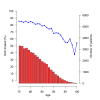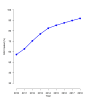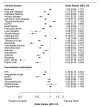Treatment patterns for oral anticoagulants in older patients with atrial fibrillation: a retrospective, cross-sectional, nationwide study from Denmark
- PMID: 36581981
- PMCID: PMC9438197
- DOI: 10.1136/bmjopen-2022-062353
Treatment patterns for oral anticoagulants in older patients with atrial fibrillation: a retrospective, cross-sectional, nationwide study from Denmark
Abstract
Objectives: Atrial fibrillation (AF) is a predominant risk factor of ischaemic stroke and treatment with oral anticoagulants (OACs) is recommended in all patients with risk factors. This study sought to examine treatment patterns of OACs in older patients with AF.
Design: Retrospective, cross-sectional study.
Setting: Danish nationwide administrative and clinical registers and databases.
Participants:
A total of 40 027 patients,
Primary and secondary outcomes measures: The primary event of interest was claimed prescriptions for OACs within 180 days after first hospital contact due to AF. Proportions of patients treated with OACs were estimated and clinical factors associated with the probability of receiving OAC treatment were identified using adjusted logistic regression models.
Results: A total of 40 027 patients were included with a slight majority of women (54%). The median age was 81 years (IQR 78-86). We found that an overall 32 235 patients (81%) were prescribed an OAC after their first hospital contact due to AF with a marked increase in the proportion of patients treated from 2010 to 2018. Factors related to a decreased probability of receiving treatment were bleeding risk factors such as a history of haemorrhagic stroke (OR 0.21, 95% CI 0.16 to 0.27), any bleeding (OR 0.58, 95% CI 0.53 to 0.62) as well as markers of frailty such as osteoporosis (OR 0.78, 95% CI 0.71 to 0.85).
Conclusion: In this large nationwide study, we found that in older patients with AF, the overall rates of OAC prescription were generally high (~80%) and increasing during the last decade. Factors associated with not receiving guideline recommended OAC treatment were generally related to bleeding risk factors or frailty.
Keywords: adult cardiology; anticoagulation; clinical pharmacology; thromboembolism.
© Author(s) (or their employer(s)) 2022. Re-use permitted under CC BY-NC. No commercial re-use. See rights and permissions. Published by BMJ.
Conflict of interest statement
Competing interests: None declared.
Figures



Similar articles
-
Effectiveness and Safety of Anticoagulation Therapy in Frail Patients With Atrial Fibrillation.Stroke. 2022 Jun;53(6):1873-1882. doi: 10.1161/STROKEAHA.121.036757. Epub 2022 Feb 3. Stroke. 2022. PMID: 35109686
-
Incidence of nonvalvular atrial fibrillation and oral anticoagulant prescribing in England, 2009 to 2019: A cohort study.PLoS Med. 2022 Jun 7;19(6):e1004003. doi: 10.1371/journal.pmed.1004003. eCollection 2022 Jun. PLoS Med. 2022. PMID: 35671329 Free PMC article.
-
Effect of Mailing Educational Material to Patients With Atrial Fibrillation and Their Clinicians on Use of Oral Anticoagulants: A Randomized Clinical Trial.JAMA Netw Open. 2022 May 2;5(5):e2214321. doi: 10.1001/jamanetworkopen.2022.14321. JAMA Netw Open. 2022. PMID: 35639381 Free PMC article. Clinical Trial.
-
It can be safe to discontinue oral anticoagulants after successful atrial fibrillation ablation: A systematic review and meta-analysis of cohort studies.Medicine (Baltimore). 2023 Oct 20;102(42):e35518. doi: 10.1097/MD.0000000000035518. Medicine (Baltimore). 2023. PMID: 37861532 Free PMC article.
-
Ischaemic stroke and bleeding rates in 'real-world' atrial fibrillation patients.Thromb Haemost. 2011 Jul;106(1):34-44. doi: 10.1160/TH10-10-0674. Epub 2011 May 26. Thromb Haemost. 2011. PMID: 21614409 Review.
References
-
- Hindricks G, Potpara T, Dagres N, et al. . 2020 ESC guidelines for the diagnosis and management of atrial fibrillation developed in collaboration with the European association for Cardio-Thoracic surgery (EACTS): the task force for the diagnosis and management of atrial fibrillation of the European Society of cardiology (ESC) developed with the special contribution of the European heart rhythm association (EHRA) of the ESC. Eur Heart J 2021;42:373–98. 10.1093/eurheartj/ehaa612 - DOI - PubMed
Publication types
MeSH terms
Substances
LinkOut - more resources
Full Text Sources
Medical
